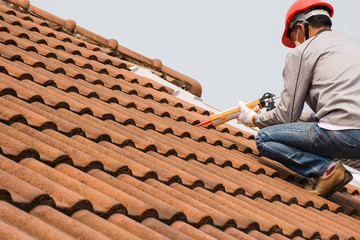Whether you’re a roof repair expert or an average homeowner, you know that your home isn’t safe without a good, fully-functioning roofing system. That’s why it’s important to understand how to repair a roof on your own when it comes time for it and when it’s necessary to call in the pros.

If you notice wrinkles in your flashing, it’s a sign that your roofers may need to make some repairs. Roofing Companies can replace the old flashing with new ones. This will help prevent future leaks and water damage. Shingles are a crucial component of any roof. They’re the first defense against water leaks that penetrate your home and cause wood rot and other structural problems.
When you see a spot of water not covered by your roof, inspect the area for damaged or missing shingles and granules that have been blown off the shingle. If you find evidence of a problem, repair it quickly to save money and protect your home from damage.
Using a pry bar, pry up the shingle directly above the missing or damaged one. Then, push it under the shingle above that and the one above that. A pry bar can also be used to loosen the four nails that secure a shingle in place. These are usually located about a quarter of an inch from the top and bottom of the shingle. Once the nails are loosened, the shingle should come off easily.
Flashing is a thin sheet of material that is used to seal or protect areas on your roof where two surfaces meet. This includes valleys, chimneys, vent pipes, skylights, and other locations that are susceptible to leaks.
Flashing also helps direct water away from vulnerable points, which reduces the chances of leaks and damage to your home. It is a critical element of a roofing system, and it is a good idea to have your roofers inspect your flashing periodically.
Typically, it’s not uncommon for flashing to become loose over time. This can happen due to a number of factors, including deterioration or improper installation.
Vents are one of the most important parts of a roof, as they help keep your attic cool and dry. They also help prevent water leaks, mold growth and structural damage that can occur if there’s not proper ventilation from your attic to your roof.
There are a few different types of roof vents, including ridge vents, box vents and soffit vents. All of them work to clear heat and moisture from your attic, as well as help reduce the amount of rain that seeps into your home and melts snow & ice.
The most common roofing vents are ridge vents, which are installed near the roof’s ridge, or peak. The ridge is the point where most hot air rises and escapes through your roof naturally, so it’s crucial that your vents are placed correctly to help maintain proper attic ventilation.
Gutters are a key component of any roof’s system and protect the home by shedding rainwater away from its foundation. They also prevent soil erosion, muddy landscaping areas and mold growth.
The lifetime of your gutters will depend on their material, style and upkeep. Metal gutters generally last 20 to 25 years, while copper is a luxury option that can last up to 100 years.
Regardless of the material, it is essential that you have your gutters regularly cleaned. Over time, tree leaves, twigs, and other debris can build up in your gutters and clog them.
Check your gutter for loose or missing hangers or end caps, which are small pieces of hardware that keep the gutter attached to your house. If these pieces are lost, they can eventually give in and make a section of your gutter collapse. Having them replaced promptly can prevent this from happening.
Roof repair refers to fixing any damage, leaks, or other issues that may arise with a roof. This can include replacing damaged shingles or tiles, repairing leaks or cracks, fixing gutter systems, and addressing any structural damage that may have occurred. Roof repair is important for maintaining the integrity of a building, as a damaged roof can lead to water damage, mold growth, and other structural issues. Regular inspections and maintenance are often recommended on a roof to catch and address any issues before they become more serious problems.